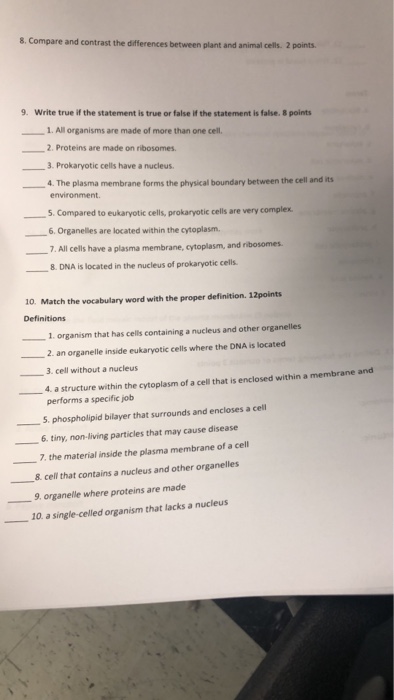84 Vacuole Structure In Animal Cell
Vacuole in biology a space within a cell that is empty of cytoplasm lined with a membrane and filled with fluid. Vacuoles - Storage Bins to the Cells Vacuoles are storage bubbles found in cells.
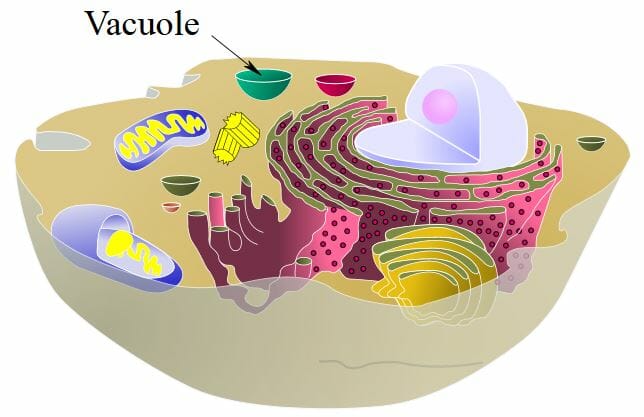
Vacuole Definition Structure And Functions Biology Dictionary
Its one of the largest organelles found in cells and its shaped like a large sac.
Vacuole structure in animal cell. Alternatively they may be prepared artificially in which case they are called liposomes. Especially in protozoa single-celled eukaryotic organisms vacuoles are essential cytoplasmic organs organelles performing functions such as storage ingestion digestion excretion and. It is a space or vesicle within the cytoplasm of a cell enclosed by a membrane and naturally containing fluid.
The function and significance of vacuoles differs greatly according to the cell type. The membranes are composed of phospholipids. Thus this membrane does not allow harmful substances present in here from entering and harming the rest of the cell.
Know what is cell structure in Biology Definition Process Types Meaning Examples along with important questions. Sometimes a single vacuole can take up most of the interior space of the plant cell. The vacuole structure is designed to aid this important cell organelle which is one of the key plant and animal cell differences.
A vacuole is a membrane-bound cell organelle. The nucleus in plant cells is lens-shaped and peripheral in position due to a large central vacuole. Structure Of Animal And Plant Cell Download Scientific Diagram Both all animals and plants are made of cells.
A vesicle is a small structure within a cell consisting of fluid enclosed by a lipid bilayer. The most important structures of plant and animal cells are shown in the diagrams below which provide a clear illustration of how much these cells have in common. The main function of vacuoles in animal cells is to isolate and remove waste products from the other organelles and the cytoplasm.
Vacuoles generally have acidic pH values. Central Vacuole The central vacuole is found only in plant cells. Vesicles form naturally during the processes of secretion exocytosis uptake phagocytosis and transport of materials within the cytoplasm.
Vacuoles means empty space are cavities in the cytoplasm especially in plant cells surrounded by a cytoplasmic membrane the tonoplast and filled with a watery fluid called the cell sap containing water and various substances in solution or suspended state. Animal Cells In animal cells vacuoles serve more subordinate roles such as assisting in endo- and exocytosis or basic storage of food and waste. However they are not prominent as in case of a plant cell.
It is filled with water and is pressurised like a balloon. A vacuole is an organelle in cells which functions to hold various solutions or materials. In animal cells vacuoles are generally small and help sequester waste products.
Vacuole Function in Animal Cells. The animal cell also contain a few small vacuoles. Although animal cells contain vacuoles they do not contain large central vacuoles.
Its membrane the tonoplast helps to separate its contents from those floating in the cytoplasm. It is spherical in animal cells. This includes solutions that have been created and are being stored or excreted and those that have been phagocytized or engulfed by the cell.
A cell is the basic unit of life. They are surrounded by a thin membrane and filled with fluid and any molecules they take in. In animal cells the vacuoles can be anywhere in the cells cytoplasm except in the nucleus or cell membrane.
They are found in both animal and plant cells but are much larger in plant cellsVacuoles might store food or any variety of nutrients a cell might need to survive. The membrane surrounding the vacuole is known as tonoplast. Structure of Cell.
A vacuole is a structure found in animal plant bacteria protist and fungi cells. In plant cells vacuoles help maintain water balance. Vacuoles may accumulate food or any diversity of nutrients a cell may require to survive.
In fact vacuoles move around in the cell in order to dispose of any waste they hold. The components of the vacuole known as the cell sap differ from that of the surrounding cytoplasm. They are found in both animal and plant cells but are much bigger in plant cells.
Because of which it is the most prominent cell organelle in most of the plant cells. A vacuole is a membrane bound structure found in the cytoplasmic matrix of a cell. Vacuoles have a simple structure.
The open spaces found in the cytoplasm are the vacuole. In animal cells vacuoles tend to play a lesser role.
28+ Animal Cell Nuclear Membrane Function
Transcription copying of deoxyribonucleic acid DNA in the nucleus and translation decoding of the message into protein in the cytoplasm. Holes in the nuclear membrane that allow RNA to move in and out of the nucleus.
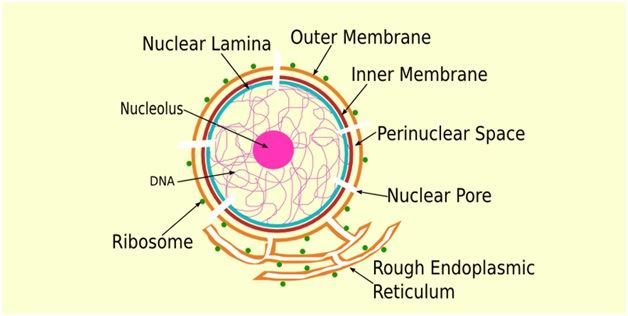
Nuclear Membrane Structure Function Of Nuclear Membrane
It is found in both plant and animal cell.

Animal cell nuclear membrane function. Start studying Names and Functions of the Organelles in Plant and animal cells. Nucleus The control center of the cell. The functions of nuclear membranes can be more easily grasped by knowing its structural components.
A cell has many jobs such as building proteins converting molecules into energy and removing waste products. Animal Cell Definition Structure Parts Functions And Diagram Dna contains all the. A nuclear membrane is a double membrane that encloses the cell nucleus.
The nuclear membrane includes an array of small holes or pores that permit the passage of certain materials such as nucleic acids and proteins between the nucleus. Ribosome small organelles composed of rna rich cytoplasmic granules that are sites of protein synthesis. The nuclear membrane has the function of protecting the dna inside the nucleus from surrounding exterior substances.
Here one must be aware of a fact that prokaryotic cells dont have membranes around their nuclei. In eukaryotic cells the double membrane enclosing DNA and any other genetic material is known as nuclear membrane. The animal cells consists of centriole which carries out cell division.
Cytoplasm Jelly-like fluid that surrounds and protects the organelles. Compared to the structure of the bacterial cell this gives greater control. As stated before animal cells are eukaryotic cells with a membrane-bound nucleus.
Animal cell diagram and functions. Cell Membrane A double layer that supports and protects the cell. Animal cell nucleus has a lot of functions like controlling all the cellular activities and carrying the hereditary information of the cell.
It serves to separate the chromosomes from the rest of the cell. Additionally the nuclear envelope can regulate what. The animal cells have an organized nucleus with a nuclear envelope.
In 1831 Robert Brown first discovered the nucleus. Lysosome Contains digestive enzymes that destroy damaged organelles and invaders. Learn vocabulary terms and more with flashcards games and other study tools.
Contains the DNA Nuclear Membrane Surrounds the nucleus. It separates the fluid inside the nucleus of a cell from. Furthermore these cells exhibit the presence of DNA inside the nucleus.
They also comprise other membrane-bound organelles and cellular structures which carry out specific functions necessary for a cell to function properly. This genetic information is called deoxyribonucleic acid dna. The presence of a nuclear membrane in eukaryotes permits separation of the two phases of protein synthesis.
The nuclear membrane also regulates which substances can enter or exit the nucleus. The function of the nuclear membrane in an animal cell is to hold the DNA inside the nucleus in order to protect it from surrounding substances. Animal cell diagram nuclear membrane.
It separates the fluid inside the nucleus of a cell from the material outside. The nucleus is a dense and most significant component of the cell. The eukaryotic cells have cell organelles that are lacking in prokaryotic cells except the ribosomes.
Allows materials in and out. Cytoplasm is supposed to be the matrix or gel like substancefluid present inside the cell. Along with that it possesses locomotory structures.
Function of Nuclear Membrane The nuclear membrane keeps your DNA inside the nucleus to protect it from surrounding substances in the cytoplasm. Separated from the cytosol a compartment called the nucleus store genetic material in eukaryotic cells. The animal cell functions nuclear envelope or nuclear membrane is membranes that separate nuclei of eukaryotic cells and the cytosol.
The nuclear membrane also known as the nuclear envelope surrounds every nucleus found in animal cells.
57 Animal And Plant Cells Worksheet Oxford Illustrated Science Encyclopedia
Communication within animal cells. How do you know which type of cell it is Source Oxford Illustrated Science Encyclopedia http www.

A Belowground Perspective On Dutch Agroecosystems How Soil Organisms Interact To Support Ecosystem Services Sciencedirect
Some of the worksheets displayed are Plant and animal cells Animal and plant cells work Plant and animal cells Animal reproduction An introduction to the circulatory system 4 activity work Enzymes and their functions Match column a with column write the letter of the.
Animal and plant cells worksheet oxford illustrated science encyclopedia. Plants and Animal Cells 11. _____ Animal and Plant Cells Worksheet. The worksheets recommended for students of grade 4 through grade 8 feature labeled animal and plant cell structure charts and cross-section charts cell vocabulary with descriptions and functions and exercises like identify and label the parts of the animal and plant cells color the cell organelles match the part to its description fill in the blanks crosswords and more.
Acts like a transport system to deliver chemicals made by the ribosomes 6. Animal and plant cell labeling key. Plants and Animal Cells 11.
Partnerships for reform through investigative science and math plants and animal cells. Learned about the differences between plant and animal cells if coral is a plant or. Teachers Cell Parts Answer Guide.
Partnerships for Reform through Investigative Science and Math. Animal and plant cells share many similarities since theyre both eukaryotes which means that they have a membrane-bound nucleus plant cells are often larger than animal cells well except for eggs the largest single animal cell is an unfertilized ostrich egg which weighs around 15 kilograms so lets discuss similarities both animal and plant cells have membrane bound organelles they also both have cytoplasm a cell. Animal and plant cells worksheet.
A cell is the basic unit of life. Plant cell walls are designed for the process of photosynthesis. Microbes and People.
Information obtained from Science Fusion - The Diversity of Living Things - Chapter 1 Lesson 1 Cells Video. Grade labeling of plant and animal cells 4th grade plant and. Plant and Animal Cell Worksheets.
An A-Z of microorganisms in our lives by Neeraja Sankaran Orgnized in an A-to-Z format this reference guide is designed to help users find their way in the vast--and sometimes bewildering--world of living things too small to be discerned with the naked eye. Previous to dealing with Animal Cell Worksheet Answer Key you should know that Knowledge is actually your step to a more rewarding the next day plus studying wont just cease as soon as the school bell ringsWhich remaining mentioned most people provide you with a number of simple still educational articles or blog posts and themes built made for just about any educational purpose. Plant cells chloroplasts a large vacuole and a thick cell wall.
They both have a defined nucleus cell membrane and are protected by cytoplasm. Partnerships for Reform through Investigative Science and Math. Oxford Illustrated Science Encyclopedia.
There are two uniquely formed and often studied cell types. 9 Mitochondria Nucleus Golgi Body Ribosomes Endoplasmic Reticulum Cytoplasm Cell Membrane. Oxford Illustrated Science Encyclopedia.
Resources for the study of biology. Partnerships for Reform through Investigative Science and Math. Photocopy both Animal and Plant Cell Worksheets Cell Parts and make a transparencies of each cell sample picture and the Coral Cell with Zooxanthellae Cover the instructions on this.
Provides energy or power for the cell 3. Oxford illustrated science encyclopedia. Partnerships for reform through investigative science and math plants and animal cells.
It do not have a cell wall Source. Worksheets are plant and animal cells animal and plant cells work the einle picture. Oxford Illustrated Science Encyclopedia.
_____ Animal and Plant Cells Worksheet. Cell uxl encyclopedia of science. Worksheets are plant and animal cells animal and plant cells work the einle picture.
Worksheets are Plant and animal cells Animal and plant cells work Plant and animal cells Animal reproduction An introduction to the circulatory system 4 activity work Enzymes and their functions Match column a with column write the letter of the. Found in plant cells and is responsible for photosynthesis 2. _____ Word Bank Cell Membrane Cell Wall Mitochondria Nucleus Vacuole Ribosome Golgi Body ER Chloroplast Cytoplasm Animal and Plant Cells.
These organelles read the instructions from the DNA to make proteins. Oxford illustrated science encyclopedia. Displaying all worksheets related to - Oxford Illustrated Animal Cell Answer Key.
Of Plant and Animal Cells 7L12 - Compare the structures and functions of plant and animal cells including major organelles. The part of the cell where the DNA is stored 8. Plants and Animal Cells 11 5 Partnerships for Reform through Investigative Science and Math jadayah canteen Name_____ Date.
Oxford Illustrated Science Encyclopedia. Displaying top 8 worksheets found for - Oxford Illustrated Science Encyclopedia. Entries cover environmental industrial and food microbiology in.
Click on pop-out icon or print icon to worksheet to print or download. Which type of cell is this 2. _____ Word Bank Cell Membrane Cell Wall Mitochondria Nucleus Vacuole Ribosome Golgi Apparatus Endo.
Partnerships for Reform through Investigative Science and Math Name Animal and Plant Cells Worksheet Questions 1. Get And Sign Animal And Plant Cells Worksheet 1 1 Answer Key Form. How living things respond to their.
Oxford Illustrated Animal Cell Answer Key Showing top 8 worksheets in the category - Oxford Illustrated Animal Cell Answer Key. Plants and Animal Cells 11 5 Partnerships for Reform through Investigative Science and Math Name_____ Date. Plants and Animal Cells 11.
Animal and plant cells worksheet. Some of the worksheets for this concept are Plant and animal cells Animal and plant cells work The einle picture the heinle dictionary English Helping your child learn science pdf Oxford solutions advanced student answer key The oxford companion to philosophy new.
83 Comparison Of Organelles In Plant And Animal Cells
Plant cells have chloroplasts because they make their own food. So even though plants and animals are very different organisms they have some very similar structures within their cells.
Solved 8 Compare And Contrast The Differences Between Pl Chegg Com
Differences Between Plant And Animal Cells The significant differences between plant and animal cells.

Comparison of organelles in plant and animal cells. Figure 48 these figures show the major organelles and other cell components of a a typical animal cell and b a typical eukaryotic plant cell. One organelle present in animal cells but absent in virtually all plant cells is the centriole. The lysosomes are the cells garbage disposal In plant cells the digestive processes take place in vacuoles.
Vacuoles are small Lysosomes are common Both Cell Membrane Nucleus Nuclear Membrane Cytoplasm Endoplasmic Reticulum Ribosome Mitochondrion Vacuole Lysosome Plant. Based on the table above it shows that both animal and plant cells have similar structure given the fact that they are eukaryotic cells. A plant cell usually has a single large and prominent vacuole which is a bladder-like structure containing water and other solutes thus serving as a storehouse of the cell.
Each difference will now be discussed in detail. Enzymes within the lysosomes aid the breakdown of proteins polysaccharides lipids nucleic acids and even worn-out organelles. The Difference Between Plant and Animal Cells While both plant and animal cells are eukaryotic and share many similarities they also differ in several ways.
Every eukaryotic cell animal cells plant cells you name it is enveloped by a plasma membrane. Plant and animal. They also have the same membranes cytoskeletal elements and cytosol.
Endoplasmic Reticulum Smooth and Rough Present. Round irregular shape Rectangular fixed shape Chloroplast. Animal cells may or may not contain one or many smaller vacuoles.
29 rows Both plant and animal cells comprise membrane-bound organelles such as endoplasmic. A membrane-bound fluid-filled sac inside plant and animal cells. Food vacuoles of the Amoeba digest smaller cells captured by phagocytosis.
Plant and animal cells have organelles to help control organize and maintain the cell. They have membrane-bound organelles like the nucleus endoplasmic reticulum mitochondria lysosomes Golgi apparatus and peroxisomes. One example of this is that plant cells have chloroplasts that allow them to perform photosynthesis for energy but animal cells do not have chloroplasts since they get their energy elsewhere.
Animal cells dont have chloroplasts. Cell nucleus endoplasmic reticulum cell membrane cytoplasm and. Cell Wall Chloroplast Vacuoles are large and few Lysosomes are uncommon.
It is very rare. Organelles are found in Eukaryotic cells and are tiny structures inside cells that carry out different functions to insure that homeostasis is maintained. 13 rows Comparison of Cell Organelles of Plant Cell and Animal Cell.
Contractile vacuoles of protists such as the Paramecium are specialized organelles for expelling excess water. Introduction to the Cell Guided Notes. Plant and animal cells have many of the same organelles.
In animals the centriole is present and. Differentiate between plant and animal cells Unicellular organisms consist of just one cell that carries out all life. Learn about the key differences.
The major differences between animal and plant cells include the presence of a cell wall chloroplasts and large vacuoles in plant cells but not in animal cells. Plant cells have large central vacuoles that occupy much of the cell volume. Comparing Plant Animal and Bacteria Cells You should know You should be able to All living organisms are made of cells Draw cells that are seen under a light microscope Cell organelles carry out functions within eukaryotic cells.
Animal cells have another set of organelles not found in plant cells. These are functions that are mainly done by the.
60 Animal Cell Under Transmission Electron Microscope
The image is magnified and focused onto an imaging device such as a fluorescent screen or a. Some variation of this microscope can also penetrate down to the subatomic particles like electrons.
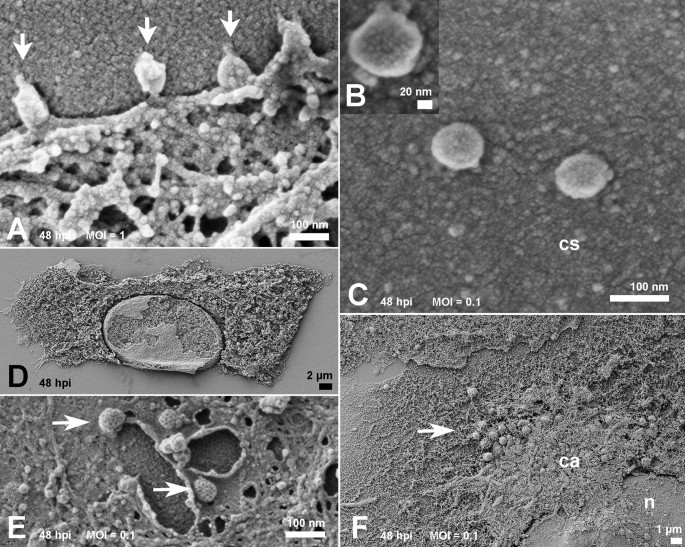
Ultrastructural Analysis Of Sars Cov 2 Interactions With The Host Cell Via High Resolution Scanning Electron Microscopy Scientific Reports
Spirogyra Under Microscope 10x.
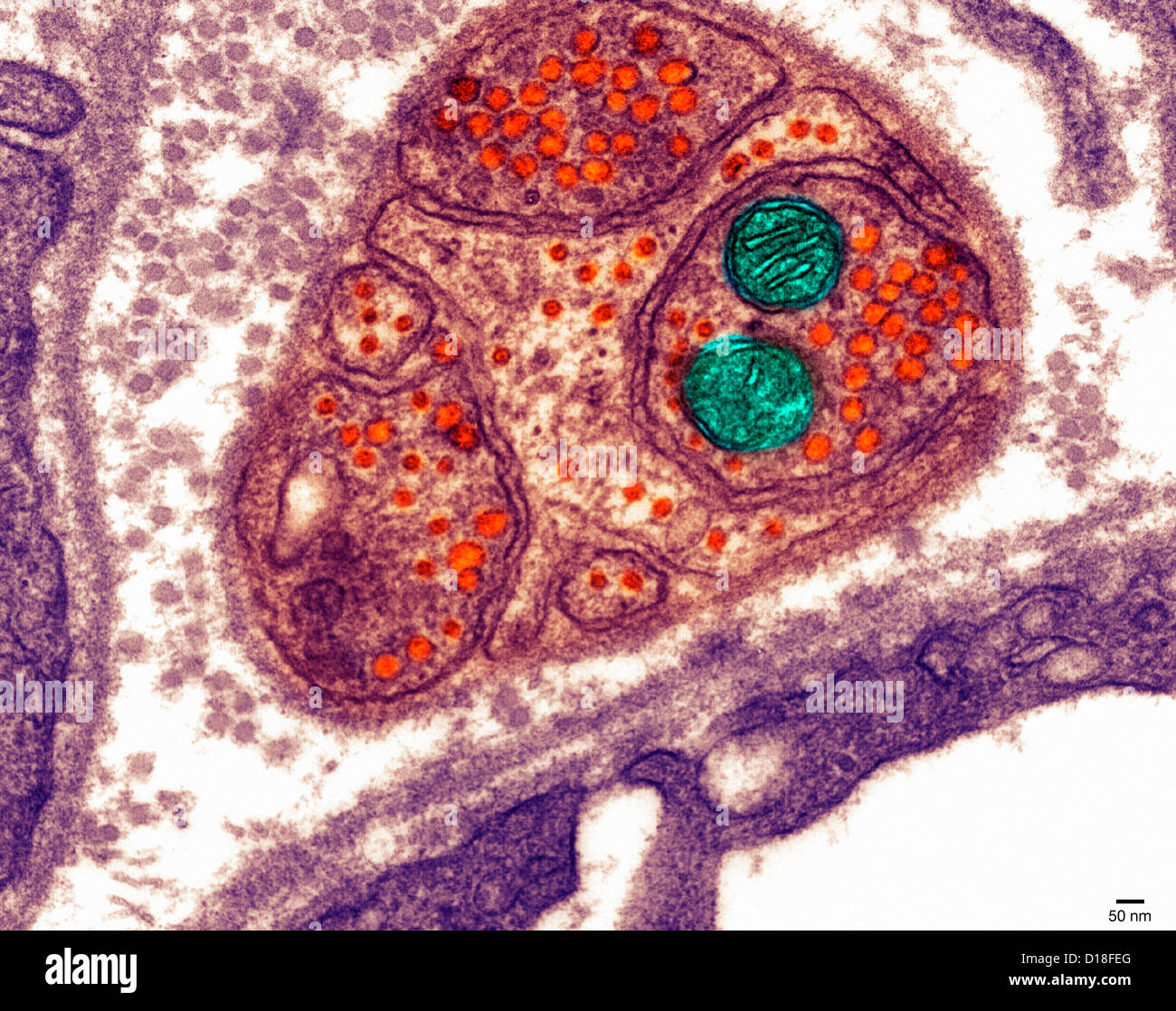
Animal cell under transmission electron microscope. Methods In Cell Biology. Methods In Cell Biology. Blood opens an overview page on the different blood cells.
The cell wall nucleus vacuoles mitochondria endoplasmic reticulum Golgi apparatus and ribosomes are easily visible in this transmission electron micrograph. You see that many features are in common. Magnification 50 000x Transmission Electron Micrograph Tem.
Monster Designs Animal Cell Under An Electron Microscope. Microscope Cell Images Animal Cells All Living Things Are Made Up. Under the terms of the Creative Commons Attribution License which permits unrestricted use distribution and reproduction in any medium provided the.
Charles Daghlian Dartmouth Electron Microscope Facility via Wikimedia Commons. However no obvious structural damage was apparent and several repeated scans gave the same images. Commencing circa 1950 the development of the transmission electron microscope revolutionized microscopy progressively bringing it.
This would allow the cell to be viewed in a lot more detail than what it was with a light microscope however the image is only ever produced in shades grey. Fast Transmission Electron Microscope TEM. The microscope can not only distinguish between individual atoms but even see them when they were about only 04 angstroms apart half the length of a chemical bond.
Exercise 3 Cells Organelles And Inclusions. Liquid cell electron microscopy e. The plant cell as more rigid and stiff walls.
The diagram below shows the general structure of an animal cell as seen under an electron microscope. The nature of the image depends on the type of light or electron microscope used and on the way in which the cell or tissue has been prepared for observation. Thats the major difference between plant and animal cells under microscope.
Human and animal mitochondria. You know Animal cell structure contains only 11 parts out of the 13 parts you saw in the plant cell diagram because Chloroplast and Cell Wall are available only in a plant cell. Usb Microscope Software Windows 10.
Isolated mitochondria as well as cell suspensions to be completed in. However the transmission electron microscope uses a high voltage beam which passes through a thin sample showing the internal structure of the cell. These are both specific types of.
Table D leads to images of electron microscopes or protocols for tissue preparation. Electron microscope The images from the transmission electron microscope show a razor-thin layer just two atoms thick of two atoms bonded together. The development of electron microscopes has greatly extended the ability to resolve sub-cellular particles and it has provided new information on the organization of plant and animal tissues.
Trachea epithelium showing ciliated cells cells with hair-like projections. The Great Story Iii An Animal Cell A Eukaryote Before The. Transmission Electron Microscope Tem Micrograph Showing Several.
Below the basic structure is shown in the same animal cell on the left viewed with the light microscope and on the right with the transmission electron. Transmission Electron Microscope TEM Zoology for IAS IFoS and other competitive exams. Here is an electron micrograph of an animal cell with the labels superimposed.
In this lab you observe typical undifferentiated plant cells parenchymaYou should have note the characteristics that plant cells share with all other eukaryotic cells the nucleus and membrane-bound organelles and also note the characters where plant cells differ from animal cells large central vacuole plastids and cell wall. Animal cells have a basic structure. All you need for this is a microscope with a basic transmitted light source and enough magnification to resolve individual yeast cells.
Transmission and some scanning electron microscopic images oforgans. Head and mouth of a. In transmission electron microscope TEM a beam of electrons is transmitted through the section of a specimen and an image is formed by the interaction of the electrons transmitted through the specimen.
The animal cell is more fluid or elastic or malleable in structure. What can be seen under a electron microscope. Under the intense radiation of the electron microscope 011 electron per Å 2 the question of viability of cells naturally arises because the amount of radiation absorbed during highmagnification imaging is sufficient to cause cell death.
The transmission electron microscope.
